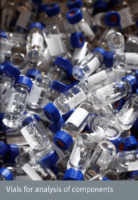The Scientific Committee on Emerging and Newly Identified Health Risks (SCENIHR) is a committee within the European Commission for Risk Assessment. SCENIHR has recently published an opinion on the use of bisphenol A (BPA) in medical devices¹. Contribution to the opinion was given by SCENIHR members and external experts including Prof. A Hensten, UiT The Arctic University of Norway, and Dr H. Molvig Kopperud from NIOM.
 One key question in the task of the working group was to determine whether levels of exposure to BPA from the use of the various medical devices, such as implants, catheters and dental devices, containing BPA could raise health concerns. Bisphenol A is a building block of some dental monomers, such as Bis-GMA, Bis-EMA and BADGE, used in restoration materials, and is also used for the production of many polycarbonate materials. Discussions on the exposure and health risks related to BPA from dental materials have been going on with varying intensity since the mid 90’s.
One key question in the task of the working group was to determine whether levels of exposure to BPA from the use of the various medical devices, such as implants, catheters and dental devices, containing BPA could raise health concerns. Bisphenol A is a building block of some dental monomers, such as Bis-GMA, Bis-EMA and BADGE, used in restoration materials, and is also used for the production of many polycarbonate materials. Discussions on the exposure and health risks related to BPA from dental materials have been going on with varying intensity since the mid 90’s.
SCENIHR evaluated several exposure scenarios, accounting for the material used, information related to BPA leaching, the duration of a single treatment and the frequency of treatments. For dental materials, two scenarios were considered: short-term exposure (< 24 hours after treatment) and exposure due to long-term contact with the materials. BPA exposures were estimated for different scenarios and were for dental materials found to be from 140 to 200 ng/kg bodyweight/day for children and adults, respectively, due to contact with dental materials for less than 24 hours, and from 2 to 12 ng/kg bodyweight/day due to long-term contact. Both short-term and long-term exposures were similar to or well below the values of exposure due to dietary intake.
 SCENIHR adopted the temporary oral tolerable daily intake (t-TDI) of 4 μg/kg bodyweight/day derived by the European Food Safety Authority (EFSA)². The SCENIHR opinion considered that BPA has low systemic bioavailability by the oral route.
SCENIHR adopted the temporary oral tolerable daily intake (t-TDI) of 4 μg/kg bodyweight/day derived by the European Food Safety Authority (EFSA)². The SCENIHR opinion considered that BPA has low systemic bioavailability by the oral route.
“The SCENIHR concludes that risk for adverse effects of BPA may exist when the BPA is directly available for systemic exposure after non-oral exposure routes, especially for neonates in intensive care units, infants undergoing prolonged medical procedures and for dialysis patients … However, better data on exposure would be beneficial for the refinement of the present risk assessment, to be carried out when new data on exposure via medical devices will be available.”
With regards to dental materials, the conclusion was made that long-term oral exposure to BPA was approximately 2‰ of the t-TDI, thus posing a negligible risk for human health.
References
1) SCENIHR, Safety of the use of bisphenol A in medical devices, 18 February 2015. ISBN 978-92-79-30133-9, doi:10.2772/75546.
2) Scientific Opinion on the risks to public health related to the presence of bisphenol A (BPA) in foodstuffs. EFSA Journal 2015; 13(1): 3978, doi:10.2903/j.efsa.2015.3978.
![]() Download NIOM Newsletter April 2015
Download NIOM Newsletter April 2015
